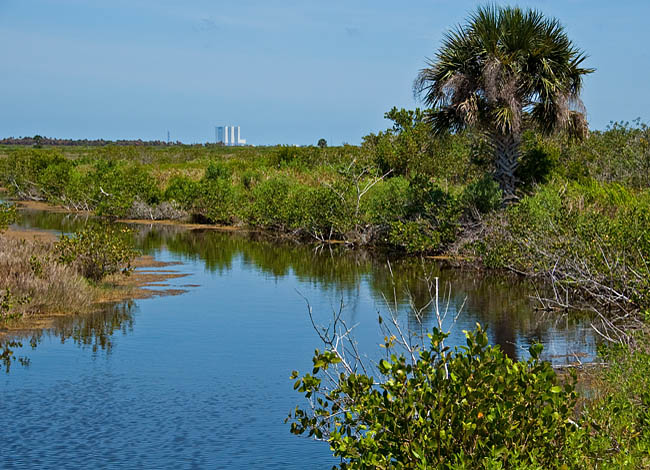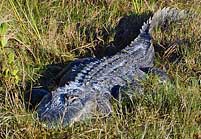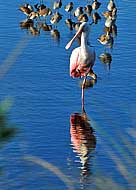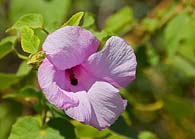|
Scenic USA - Florida Merritt Island Wildlife Refuge |

| Photos by Ben Prepelka Ben Prepelka Photography |
Stretching from the Arctic Circle in Alaska to the Caribbean Islands in the tropics,  America's National Wildlife Refuge System protects more than 150 million acres in 557 refuges. Here in east-central Florida, where NASA's Vehicle Assembly Building dominates the skyline, the Merritt Island Wildlife Refuge celebrates more than 50 years of preservation.
America's National Wildlife Refuge System protects more than 150 million acres in 557 refuges. Here in east-central Florida, where NASA's Vehicle Assembly Building dominates the skyline, the Merritt Island Wildlife Refuge celebrates more than 50 years of preservation.
Surrounding the John F. Kennedy Space Center, the U.S. Fish and Wildlife Service manages the 140,000 acre Merritt Island National Wildlife Refuge. The island's temperate climate and thousands of barrier islets provide the perfect habitat for subtropical plants and one of the highest numbers of endangered and threatened animal species.
Thousands of birds, including wood storks, peregrine falcons, shore birds, ospreys and bald eagles,  call the refuge home. Once endangered, the Florida alligator cruises through an unhindered sanctuary away from urban populations. With the longest stretch of undeveloped beach on the Atlantic coastline, the refuge provides one of the most important nesting sites for green, leatherback and loggerhead sea turtles.
call the refuge home. Once endangered, the Florida alligator cruises through an unhindered sanctuary away from urban populations. With the longest stretch of undeveloped beach on the Atlantic coastline, the refuge provides one of the most important nesting sites for green, leatherback and loggerhead sea turtles.
The Merritt Island Refuge visitor center is a great place to stop for first time visitors. Here, guests are quickly acquainted with all the different ways to experience the refuge. The Black Point Wildlife Drive, a seven mile self-guided tour, is one of the easiest  ways to see wading birds, raptors, alligators and waterfowl. Six hiking trails offer a more thorough way to explore remote ecosystems in an undisturbed environment. In the pine flatwoods and oak hammocks, drier habitats harbor different types of plant and animal species. You may also view the refuge from a boat, several areas of protected bays and creeks provide ideal locations for canoeing and kayaking. No doubt you'll see anglers stopping along the river to test their luck for saltwater species of red drum, sea trout, snook and tarpon. Here, the wildlife calendar spans the entire year, but spring, fall and winter are the best months to visit the refuge.
ways to see wading birds, raptors, alligators and waterfowl. Six hiking trails offer a more thorough way to explore remote ecosystems in an undisturbed environment. In the pine flatwoods and oak hammocks, drier habitats harbor different types of plant and animal species. You may also view the refuge from a boat, several areas of protected bays and creeks provide ideal locations for canoeing and kayaking. No doubt you'll see anglers stopping along the river to test their luck for saltwater species of red drum, sea trout, snook and tarpon. Here, the wildlife calendar spans the entire year, but spring, fall and winter are the best months to visit the refuge.
Refuge Map
Fishing and Boating Regs

|
Additional Area Attractions |
|
Copyright © 2023 Benjamin Prepelka
All Rights Reserved
